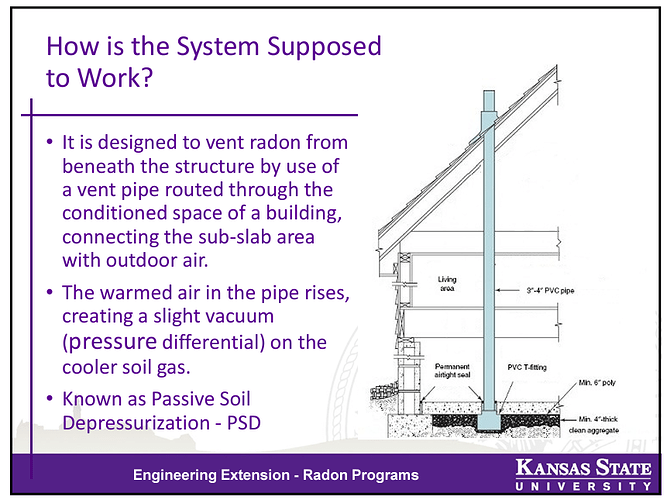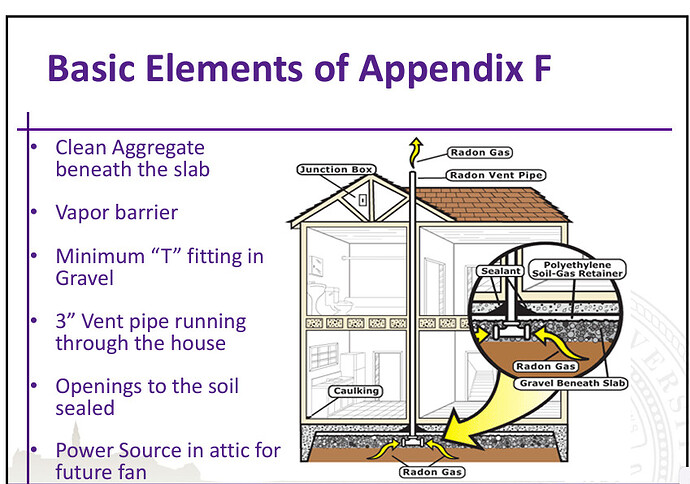I encountered an unusual situation during a recent 11-month warranty inspection. One client had elevated radon levels despite having a passive system in place. Upon activating the system, we discovered a blocked pipe, which caused a loud sucking noise in the wall where the pipe runs. Their neighbor, who was my next client, asked if I could scope their radon pipe. The pictures show what I found. Has anyone else experienced this?
The pipe will terminate in gravel, but the gravel should be below the slab, typically a T-fitting or similar. Here is a quick image from the internet. But these systems are strictly outside a standard home inspection. Did you add inspecting the passive system? Perhaps in your radon testing agreement?
What did you activate in the passive radon system? Did it have a fan on it?
I didn’t activate the system. I only scoped the line as the neighbor’s line was found to be blocked when they had their system activated. It was pulling 1.75 on the manometer. The installer said it should be at .5 - 1.0.
No surprise there…
Obviously a leak in the pipe, which would amount to a lack of sub slab depressurization.
Did these homes have basements or crawl spaces?
Where was this blockage in relation to the discharge end of the vent?
I knew generally how the systems were installed. I was looking for a collection chamber or “T” fitting. I charged an additional $75 as I was already preforming a Lateral sewer inspection.
The homes are all slab on grade. The line ran straight down from the roof. Directly through the slab an into the gravel. I was assuming there would be some type of collection chamber. I was assuming that the noise was from the gravel overly blocking the pipe causing the excessive noise. I made it very clear to the client that I was only licensed to Test for radon. They asked if I could take the pictures inside of pipe to see if there were any clear blockages.
Based on Brian’s second graphic, it appears that no T fitting was added in the gravel end. Looks like your pipe just terminated below slab at the gravel. Less effective? Idk… ![]()
Mitigation systems don’t have a collection “chamber” per say. That’s what the gravel is for. Soil gases and air still travel through it. I have seen hundreds of systems installed without a T fitting or anything else. Usually it’s just a pipe shoved into gravel, and sometimes dirt.
If the vent pipe has a leak, it won’t create enough negative pressure under the slab. If the vacuum gauge is reading 1.75 and test readings are still high, then the system is moving too much air, and not creating enough negative pressure. The likely culprits can be openings (like a sump pit or shower drain block out for example) or unsealed cracks or control joints. If there is a lot of granite gravel under the house, it too can lead to high radon even with an active mitigation system.
I agree. I don’t’ know.
A leak would cause lower readings at the manometer (fan is moving air freely). A high manometer reading indicates the fan is working hard to move air, and generally is moving less air than a lower manometer reading. (All assuming the fan is working properly)
In some soil types, 1.75 is probably common.
The client recently had the fan installed and is now concerned about the noise it produces. It is unusual to hear the sucking sound through the wall. Although the fan itself is quiet, the sucking sound is quite noticeable. The fan is located in the attic directly above the master bedroom, with the pipe running down the exterior wall behind their bed.
With the vacuum gauge reading at 1.75, do you think the additional strain could cause the fan to fail prematurely?
Correct. The system will work just fine when it’s installed like this.
That was my understanding as well. I’m planning to connect with a couple of radon mitigation professionals over coffee to gain more insight into their craft.
If you have ruled out a blockage, then there is either soil with low air permeability outside of the rock fill, or another thought could be saturated soil. Saturated soil may reduce air permeability I suppose. At the end of the day, if the radon levels are sufficiently low, then my focus would be on reducing system noise. Insulating the piping may achieve suitable results.
Possibly. The fan is working harder than it would be with a low manometer reading. Whether you consider that “premature” I guess is a matter of perspective. Higher quality fans will last longer under heavy loads typically.
In my area, many new construction homes come with passive radon mitigation systems installed. However, builders don’t activate these systems because it requires a license. Is there a way to test these systems to ensure they provide adequate airflow for proper function?
Yep! And you probably already do it all the time! A radon test. ![]()
LOL, I was thinking maybe in the pre-drywall stage. It would be a much easier remedy at that point. But I guess that isn’t really my concern. I don’t believe there is any Code requirement in VA for radon systems. Would builders be liable to fix a non-properly function system if there isn’t code to force them?
I spoke too soon. Image off of the Virginia Department of Health website. This is a county wide code, but not is the counties I operate in.
In my area, code requires a passive radon mitigation system be installed at the time of construction on new homes. A passive system that is “not functioning” basically means that it isn’t moving enough radon-laden air to reduce indoor radon levels to acceptable levels. This may be because of how the passive system is installed, or it could just be that the radon level in the soil is really high.
So in a nutshell, a test should be done once the home is completed. If the radon is above acceptable levels, the next step is to add a fan and convert the system to an active system. If radon levels are still too high, then further research needs to be done on the issue. It may need a 2nd suction point, a bigger fan, or there may be some issue with the system.
In any case, I’m not sure the contractor is required to provide a low radon home, at least in my area. That is a good question.




